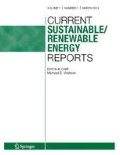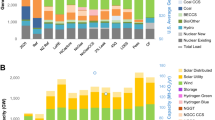Abstract
Purpose of Review
Coal-fired generation is being retired in many regions. Some argue that these retirements are exacerbated by renewable–generation policy supports. Based on these claims, there are suggestions that renewable supports be phased-out or that coal-fired generators receive their own supports. Given the inherent policy implications, we examine the impacts of renewable–energy supports and other market changes (e.g., low natural–gas prices and carbon policy) on generator profitability.
Recent Findings
Renewable–energy policy supports can affect negatively the economics of coal-fired generators. However, empirical analyses in the literature find that the main contributor to declining coal-fired generation is low natural-gas prices. To investigate these findings further, we analyze a case study that is based on Japan’s wholesale electricity market. Through this case study, we examine the relative impacts of renewable–energy and other policy and market changes on the economics of coal-fired generation.
Summary
Renewable–energy policy can impact the financial viability of coal-fired generators. However, natural-gas-price decreases have a much greater impact on the profitability of coal-fired generators than renewables do at current penetration levels.



Similar content being viewed by others
Notes
cf. FERC docket number RM18-1-000 for details of the proposed rule and FERC’s ultimate decision not to make the proposed tariff modifications.
e.g., cf. https://www.tepco.co.jp/forecast/html/area_data-j.html for Tokyo-area data.
The social-cost-of-carbon estimates are reported in 2007 USD/t-CO2. We use United States Consumer Price Index data and the simple-average FY2017 exchange rate to convert the estimates to 2007 JPY/t-CO2.
References
Papers of particular interest, published recently, have been highlighted as: • Of importance •• Of major importance
Tierney SF. 2012. Why coal plants retire: power market fundamentals as of 2012. Technical report, Analysis Group, Inc.
von Hirschhausen C. The German “Energiewende”—an introduction. Econ Energy Environ Policy 2014;3:1–12.
Sawin JL, Sverrisson F, Chawla K, Lins C, McCrone A, Musolino E, Riahi L, Sims R, Skeen J. 2014. Renewables 2014 Global status report. Technical report, Renewable Energy Policy Network for the 21st Century.
Sioshansi R. Retail electricity tariff and mechanism design to incentivize distributed renewable generation. Energy Policy 2016;95:498–508.
Knittel C, Trindade KMA. Are we fracked? The impact of falling gas prices and the implications for coal-to-gas switching and carbon emissions. Oxford Rev Econ Policy 2016;32:241–259.
Stoft S. Power system economics: designing markets for electricity. New York: Wiley-Interscience; 2002.
Fleischman L, Cleetus R, Deyette J, Clemmer S, Frenkel S. Ripe for retirement: an economic analysis of the U.S. Coal Fleet. Electr J 2013;26:51–63.
Rahmani M, Jaramillo P, Hug G. Implications of environmental regulation and coal plant retirements in systems with large scale penetration of wind power. Energy Policy 2016;95:196–210.
Mitchell C, Bauknecht D, Connor PM. Effectiveness through risk reduction: a comparison of the renewable obligation in England and Wales and the feed-in system in Germany. Energy Policy 2006;34:297–305.
Umamaheswaran S, Seth R. Financing large scale wind and solar projects—a review of emerging experiences in the Indian context. Renew Sustain Energy Rev 2015;48:166–177.
Langniss O, Wiser R. The renewables portfolio standard in Texas: an early assessment. Energy Policy 2003;31:527–535.
van der Linden NH, Uyterlinde MA, Vrolijk C, Nilsson LJ, Khan J, Ȧstrand K, Ericsson K, Wiser R. 2005. Review of international experience with renewable energy obligation support mechanisms. Technical Report ECN-C–05-025 Energieonderzoek Centrum Nederland.
Liu Y, Kokko A. Wind power in China: policy and development challenges. Energy Policy 2010; 38:5520–5529.
Sensfuß F, Ragwitz M, Genoese M. The merit-order effect: a detailed analysis of the price effect of renewable electricity generation on spot market prices in Germany. Energy Policy 2008;36:3086–3094.
Green RJ, Vasilakos N. Market behaviour with large amounts of intermittent generation. Energy Policy 2010;38:3211–3220.
Sioshansi R. Increasing the value of wind with energy storage. Energy J 2011;32:1–30.
Schill W-P, Kemfert C. Modeling strategic electricity storage: the case of pumped hydro storage in germany. Energy J 2011;32:59–88.
Shahmohammadi A, Sioshansi R, Conejo AJ, Afsharnia S. Market equilibria and interactions between strategic generation, wind, and storage. Appl Energy 2018;220:876–892.
Newbery DMG. The impact of EC environmental policy on british Coal. Oxford Rev Econ Policy 1993;9:66–95.
•• Houser T, Bordoff J, Marsters P. 2017. Can coal make a comeback? technical report, center on global energy policy. Empirical analysis of the US coal market, which finds that the low natural–gas cost is the single and largest contributor to reduced use of coal.
•• Mills AD, Wiser RH, Seel J. 2017. Power plant retirements: trends and possible drivers. Technical Report LBNL-2001083, Lawrence Berkeley National Laboratory, Berkeley, CA. Analysis based on historical data in different US regions, which shows that recent retirement of coal-fired generation has no clear correlation with renewable penetration.
•• United States Department of Energy. 2017. Staff report to the secretary on electricity markets and reliability. United States Department of Energy. The report suggests that renewable resources have a negative impact on the economics of coal-fired and nuclear generation.
Borenstein S. The trouble with electricity markets: understanding california’s restructuring disaster. J Econ Perspect 2002;16:191–211.
Wilson R. Architecture of power markets. Econometrica 2002;70:1299–1349.
Sioshansi R, Oren SS. How good are supply function equilibrium models: an empirical analysis of the ERCOT balancing market. J Regul Econ 2007;31:1–35.
Hortaçsu A, Puller SL. Understanding strategic bidding in multi-unit auctions: a case study of the Texas electricity spot market. RAND J Econ 2008;39:86–114.
Willems B, Rumiantseva I, Weigt H. Cournot versus supply functions: what does the data tell us? Energy Econ 2009;31:38–47.
• Klemperer PD, Meyer MA. Supply function equilibria in oligopoly under uncertainty. Econometrica 1989;56:1243–1277. Seminal paper that proposes supply–function–equilibrium modeling.
Burke PJ, Abayasekara A. The price elasticity of electricity demand in the united states: a three-dimensional analysis. Energy J 2018;39:123–145.
Nash JF Jr. Equilibrium points in n-person games. Proc Natl Acad Sci USA 1950;36:48–49.
Ministry of Economy Trade and Industry. Japan’s energy white paper 2017. Ministry of Economy, Trade and Industry. 2017.
Evans J, Green RJ. 2003. Why did British electricity prices fall after 1998? Cambridge Working Papers in Economics CWPE 0326, University of Cambridge, Cambridge, England, United Kingdom,.
Baldick R, Hogan WW. 2002. Capacity constrained supply function equilibrium models for electricity markets: stability, non-decreasing constraints, and function space iterations. POWER Working Paper PWP-089, University of California Energy Institute.
• Holmberg P. Numerical calculation of an asymmetric supply function equilibrium with capacity constraints. Eur J Oper Res 2009;199:285–295. Develops an efficient method to calculate an asymmetric supply–function equilibrium with capacity constraints.
Allaz B, Vila J-L. Cournot competition, forward markets and efficiency. J Econ Theory 1993; 59:1–16.
Borenstein S. The long-run efficiency of real-time electricity pricing. Energy J 2005;26:93–116.
Borenstein S, Bushnell JB, Wolak FA. Measuring market inefficiencies in California’s restructured wholesale electricity market. Am Econ Rev 2002;92:1376–1405.
Interagency Working Group on Social Cost of Greenhouse Gases United States Government. Technical support document: technical update of the social cost of carbon for regulatory impact analysis under executive order 12866. 2006.
Greenblatt JB, Succar S, Denkenberger DC, Williams RH, Socolow RH. Baseload wind energy: modeling the competition between gas turbines and compressed air energy storage for supplemental generation. Energy Policy 2007;35:1474–1492.
Denholm P, Sioshansi R. The value of compressed air energy storage with wind in transmission-constrained electric power systems. Energy Policy 2009;37:3149–3158.
Liu Y, Hunter-Rinderle R, Luo C, Sioshansi R. How climate-related policy affects the economics of electricity generation. Curr Sust/Renew Energy Rep 2021;8:17–30.
Downward A. Carbon charges in electricity markets with strategic behavior and transmission. Energy J 2010;31:159–166.
Acknowledgements
The authors thank Antonio J. Conejo (The Ohio State University), Makoto Tanaka (National Graduate Institute for Policy Studies), Andy Philpott (The University of Auckland), and Armin Sorooshian (University of Arizona) for helpful comments and discussions. The first author thanks Tokushu Tokai Paper Co., Ltd. for its financial support of his Ph.D. studies at The Ohio State University.
Funding
This work was supported by National Science Foundation Grant 1808169.
Author information
Authors and Affiliations
Corresponding author
Ethics declarations
Competing Interests
The authors declare no competing interests.
Human and Animal Rights and Informed Consent
This article does not contain any studies with human or animal subjects performed by any of the authors.
Disclaimer
Any opinions and conclusions that are expressed in this paper are solely those of the authors.
Additional information
Publisher’s Note
Springer Nature remains neutral with regard to jurisdictional claims in published maps and institutional affiliations.
This article belongs to the Topical Collection: Topical Collection on Zero-Marginal-Cost Market Design
Rights and permissions
About this article
Cite this article
Yagi, K., Sioshansi, R. Do Renewables Drive Coal-Fired Generation Out of Electricity Markets?. Curr Sustainable Renewable Energy Rep 8, 222–232 (2021). https://doi.org/10.1007/s40518-021-00189-1
Accepted:
Published:
Issue Date:
DOI: https://doi.org/10.1007/s40518-021-00189-1




